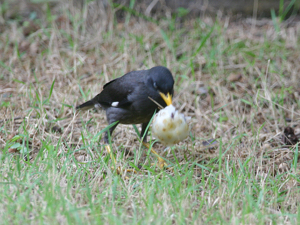On 21st July 2006 at 3.30 pm, as I was entering my garden to do some weeding, I surprised a male Asian Koel (Eudynamys scolopacea) together with a family of Javan Mynas (Acridotheres javanicus) (two adult and a juvenile) that were on the ground below my noni tree (Morinda citrifolia). There were noni fruits on the ground and I suspected that the koel was feasting on a fruit when it was surprised by my sudden appearance. The koel flew to a nearby tree across the road and loitered there, quietly moving about on the branches as well as the boundary wall of the house in front.
Half an hour later the koel returned to the partially eaten noni fruit and continued it’s feasting. It was then that I was sure that it ate the fruit (above). A few minutes later after it had its full, it silently moved away.
It was then that a pair of Yellow-vented Bulbuls (Pycnonotus goiavier) came and continued with the feast (above). This was followed by the Javan Mynas after the bulbuls left the scene (below).

Later, I found by my gate, a mess of Alexandra palm (Archontophoenix alexandrae) seeds together with bits and pieces of the whitish flesh of the noni fruit (below). The whitish pieces still had the distinctive smell of the noni fruit. The palm seeds were clean of their flesh but traces of red skin were present.
This mess must have been regurgitated by the koel, as it has been established earlier that this bird regularly regurgitates palm seeds. I did not witness the regurgitation but circumstantial evidence suggested that the koel did it. After all, the only other birds present there then were the bulbul and the myna, both birds have not been reported to regurgitate seeds.
R. Subaraj has this to say: “Though koels do not normally go to ground, it is my believe that most birds do occasionally… especially when there is a good reason. In this case, the noni fruit must have been attractive. Many birds seldom come to ground as there are more dangers there.
“Koels regularly come to feed on the fruits of low roadside palms including Alexandra and MacArthur (Ptychosperma macarthurii).”
Input and images by YC Wee.












One Response